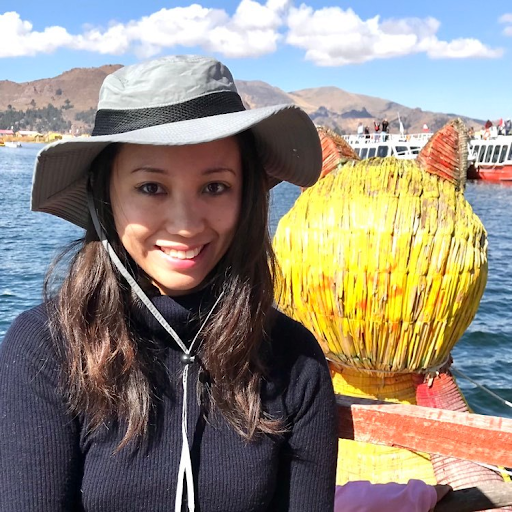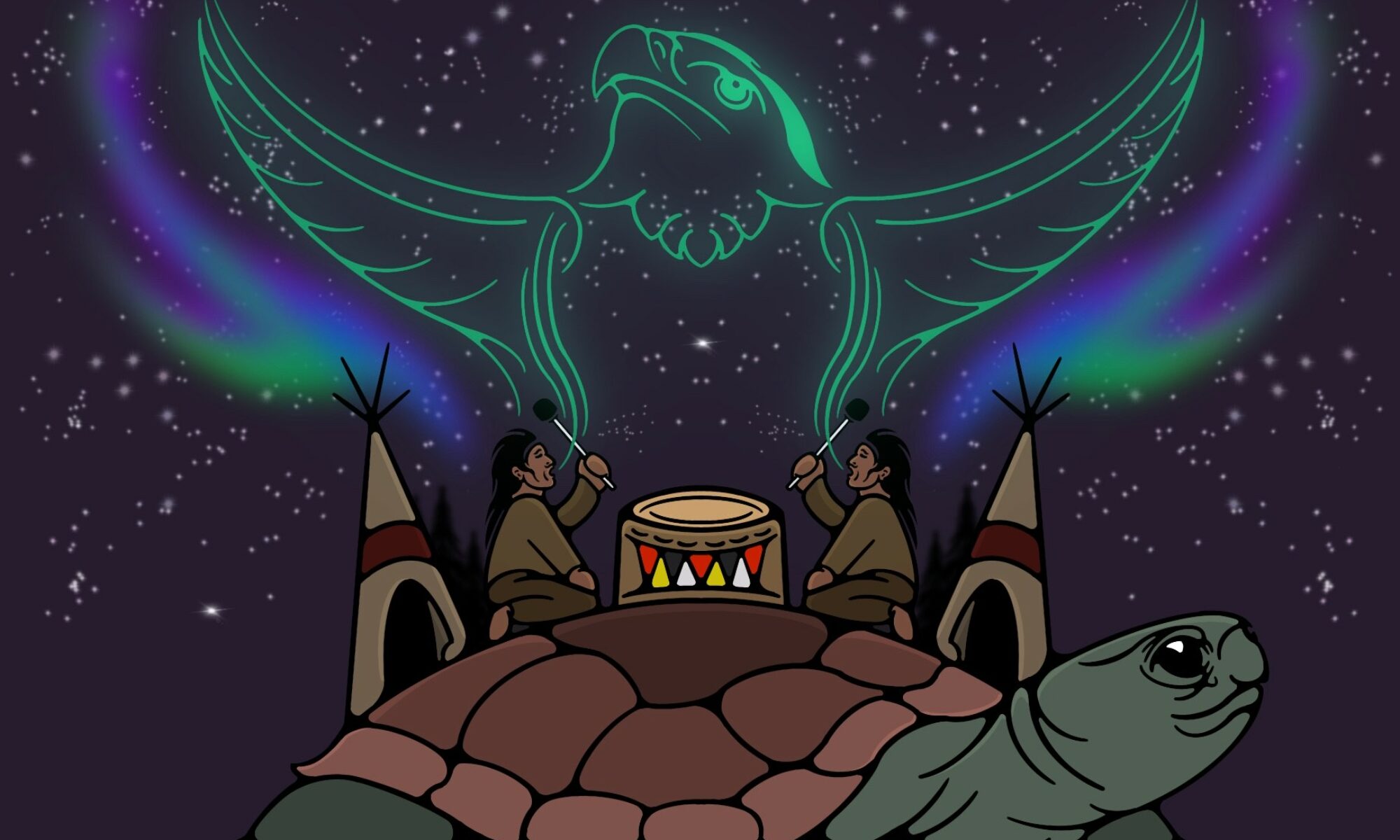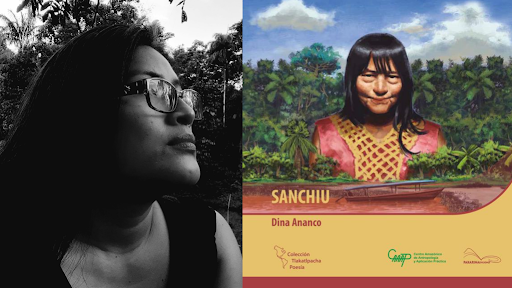Original poetry in Wampis © Dina Ananco
Introduction, selection and translation from Spanish © Katia Yoza
If you prefer to read as PDF, CLICK HERE
Dina Ananco is a Wampis and Awajun poet, translator, and interpreter. She has a BA in literature, and a Master’s degree in Peruvian and Latin American literature from Universidad Nacional de San Marcos, in Lima. She participates in poetry readings and academic events in Peru and internationally. She will be representing Peru at the Guadalajara international book fair in 2022.
Sanchiu (Lima: Pakarina Ediciones, 2021) is the first published book of poems in the Wampis language. The Wampis people are located between the south of Ecuador and the north of Peru, and they are part of the Jibaro linguistic family. The book is a bilingual edition in Wampis and Spanish, and the author translated her poems into Spanish herself. “Sanchiu” was the last name of Ananco’s grandmother, who appears on the book’s cover. This collection of forty poems is a tribute to the Wampis women which makes visible their strength and suffering, as well as current challenges inside and outside of the communities.. The poems follow the Wampis literary poetry form called “nampet” and their celebration of singing anywhere with nostalgic emotion, tenderness, humor, and dubious tone.
Auju Kiarai, etsa kanak weakai, ameka utñaitme turasha Nantu wainiakum nantu takatin nekapeakum shir wake mesemar utñaitme Antakrika utmain utñaitme Jika jikamat utñaitme Urukamtain utea, tamaka; aishri Nantu ajapa ikukmau asa utñaiti turamin aiñawai uun aiñaka Yuwisha suritujakmau asa, shir yurumin asamin, suri asamin, aishrum ukurmakin tutaiyaitme. Miñasha, ishichkisha, ashismasmeksha ujattsakia tui nuwe penkermarisha aa wisha ichinkachin najantan unuimartaj Yamaika, ichinkachika, pininchika najantaka shir nekatsji. Nuwech iñaktursakia miñak iñaktursakia, wisha unuimartaj.
Ayaymama
In the evening, when the sun goes to sleep,
you usually cry
but when you see the Moon
when you feel the full moon
you sob, longingly.
We could cry listening to your weeping.
Nostalgically you cry.
Why does she cry? when we say;
because of the abandonment of her husband Nantu cries,
the uun regularly tell you.
As you are stingy with the pumpkin,
as you are a good eater,
because you are greedy, your husband has left you, they tell you.
Warn me too, even if it is little, whispering,
where there is real clay
that I might learn how to make little vessels.
Now, we don’t know how to make the little vessels, not even the pinin.
Show me the little clay;
only to me show it to me,
so that I too can learn.
~~~
Nantu: the Moon
Uun: Elders
Pinin: vessels made of clay in which the wampis drink water or masato (traditional drink made of yucca).
Atumsha urukarmetsu Atumsha urukarmetsu, Wika, wampis anentaimtan wakeeruta jajai Wampis nuwajai metek Wampis, papin universidad aujsaujai metek Wampis nuwa uchirtinjai metek Wampis nuwa aishrinñujai metek Junisa pujaun tarach, akiitai tura patakemtai numi jinkaijai najanamujai iwarmameajai Uuntur usumajakarua imanisan usumeajai ¡Ipak atsawai! Turasha wene yakatai kapantuwa juketi Wener penkerchia ju najenchjai nakumkam shir juwawai ¡Namperaiti! Wiichur esarman atian, espejonam iimajai Wampisaitjai ¡Añawa! Arutmarua Ee, ju jaanch penkerchia jujai wampisaitjai Nakumameajai wakantrun facebooknum iwaiñaktasan 1 horasha nankamatsain 5 mil “ti penkeraiti” tau awai Nukap atsuk, wichauwaitjai, Yaunchuk uunnaka yajá ukukin nekapeajai, ijusan pujayatkun Yapirun nijaran, tarachin awikan Sapat tacortin aiña auna weamajai Turan vestido kapamñun nunkuajai, tarachjai metekmamtin ati, tusan Nunkutai kurijai najanamun nunkuran, akiitaincha winchan akian wajajai Shiram wantiniajai Wampis anentaijai anentaimsan, tajai, ¡Shirmaitjai! Nakumamkan Instagramnum iwaiñajai Eme jaiñawai aaiñak 5 mil “ti penkeraiti” tau awai Atumsha urukarmetsu, Wika juni junin yamekjai Waurkamñu nekapeajai Aya jamain nekapeajai Turasha juna atsumajai. Pujuttrun kajinmatkishtajai, tukin Bañonam enkeman tarachin nunkuajai Lima tsetsek tepeamunmasha suijkisha shir emajtatsui Ti penker iwarnarjai, peetain ashi jukin ¡Chichakai nakumrukarti, tusan, wakerajai! Urukukitaj nuna shir awantak, naka jirkiarti, tusan Miña pujutruka juwaiti, tusan, eme aneasan iyajai Kakaran chichajai Ashi uwejan awatturaiñawai Kame, wariñak chichaj nunasha shirka nekatsjai Chichamu amukamtai Tarachin, akiarmau tura peetai aiña nunaka awiran mochilanam, bolsanmaksha chumpiajai Yapirun nijajai, celularan achikan, nui internetnum taxin seamin Weajai Miña anetairjai vino umartasan Kashin tsawak Periódico suramunam tura internetnum iwaiñamunam naka jiniajai Tikich, yaktanmaya iimaru aiñajai Aujai chichaman jimartuktatjai tachamaitkun Nui wajajai, tarachin nunkuaru Uuntur uruk usumajakarukit nuna yapirui epesan Nui wajajai, wisha yakitaj nuna nekamattsan Tsawan urukukit nui wisha metek juwajai Wakantrui tura numparui juajai wii shuara jaanchrinka, wishimenka Atumsha urukarmetsu Wika nekámatsjai Turasha shir nekapeajai Ashi nunkanmaya Kankape ejetumainchau Suwa Kuwankus waja iman
I don’t know about you
I don’t know about you
Sometimes I feel like thinking as a Wampis
Other times as a Wampis woman,
Wampis university student
Wampis mother
The Wampis lover
Suddenly I wear tarach, earrings, necklaces and seed bracelets
I paint my face with my ancestors’ lines
No achiote! My red lipstick is enough
That wine-colored eyeliner that leaves my full lips pronounced
It’s a party!
I let my long hair down and I see myself in the mirror
I’m Wampis
Oh, my god
Yes, I’m Wampis in this beautiful outfit
I take pictures for my social media
In less than 1 hour I have 5 thousand likes
Suddenly I’m not me,
I feel far away from my ancestors, but I see myself so close
I wash my face, I get undressed
I put on my heels
And the red dress to keep the color
My gold necklace and shiny earrings dangle from my ears
I look beautiful
I think in Wampis and say to myself
Shirmaitjai!
I take pictures and post on my Instagram
Everyone compliments me
I get 5 thousand likes
I don’t know about you guys,
But this routine makes me tired
It drives me crazy
It overwhelms me
But I need it
So I don’t lose the habit, saying
I go into the bathroom and put on tarach
Even the sweat betrays me in the Lima winter.
I put on my best suit and the best accessories
I need the cameras at every press conference!
I need that lens to exoticize me on the front page
And I affirm that this is my culture and I am proud of it
I raise my voice
Everyone applauds me
Sometimes, I don’t even understand what I’m saying myself
The conference ends,
I take out my tarach, my necklaces and my feather earrings and put them in my backpack, my purse
I wash my face, ask for a cab by app
And off I go
I go to drink wine with my lover
The next day
I’m on the front pages of the printed and digital media
At the side of the authorities
Nothing compromises me
There I am, with my tarach
With the lines of my ancestors on my face
There I am, searching for my multiple identity
That serves me for action in every circumstance
With the color and the smile of my people in my soul and blood
I don’t know about you,
But I don’t recognize myself
And I prefer this way
To be from everywhere
With an endless root
Like Suwa in Kuankus
~~~
Tarach: traditional dress of Wampis women.
Achiote: Tree whose seeds are used to dye people’s faces red.
Shirmaitjai: I am gorgeus, I am beautiful.
Suwa: Huito, a tree whose black seeds are used to dye hair and the face. It was a woman before turning into a tree.
Kuankus: Goangos river. It is next to Rio Santiago and belongs to Morona-Santiago in Ecuador. It was the ancient land of the awajun people.
Sanchiu Ame jiimin miña uuntru pujutin nekawaitjai Chichamrumin wari jintak wekatusuitam nunasha wainkauwaitjai Uruk maaniñak armia Imtichirisha urukuk armia Warichiñak yu armia Tuin yujau armia Amiña chichamrumin nekawaitjai patarun Antukuitjai anentan Mushutkauwaitjai tsaankun Ame aja awamuka penker, nupasha takajat ayayi Anentin asamin Anentruam yurumak, kenke, inchi arau asamin Anentruam uchiram irusam pujújakuitme Tikich pujutnum weakum ankan ukurkiñaitme Uchiram, tirankim tura tiranmi uchiri aiñasha Mátsatkamusha Yamaisha ya aujmatsamtaiya Uuntrusha uruk matsámajakarukit nunasha antuktataj Ankan ukurkiñaitme ju nunka jui Turasha, anentairuinka tuké pujame Wii atsumakaisha
Sanchiu
In your eyes I learnt the history of my ancestors.
In your word I saw the roads you traveled
How they faced their enemies
What their little faces looked like
What little things they ate
Where they walked
In your word, I met my family
I listened to the anen
I inhaled the tobacco
Your field was so beautiful, it invited weeding
Because you possessed the anen
Because you sowed yucca, sachapapa, sweet potato after singing the anen
Singing the anen you had your children united
You left an emptiness in me when you went to the other life
To your children, grandchildren and great-grandchildren
To the community
Who will tell us now
The feats of the ancestors
You left me alone in this territory
Always living in my heart
You are there when I need you
When I feel sad
When I cry
When I suffer from being far away
You are always there
Because you are strong
Because you are a Wampis woman
Because you are Awajun woman
~~~
Anen: Sacred Wampis and Awajun chant. It can be transmited from deities such as Tsunki or Nunkui.
Nunkui: Female Wampis goddess who taught women the anen and how to domesticate plants.
Sachapapa: A tuber that is similar to potato.
Awan Iwarmamrau, natsanatsamtau, shiram tura penkeri. kinta sanartamunam waureawai nuke yairach aiña nuna uchupiak; shuiñan yumirin napaka nitasha nampenai Inimmameajai: kankaptinchau, ima nekas nawe aramsha urukawaintak kanawertinchau, uwejtin akusha. Nii, unuimaru, wishiwishi jas, shuar nankamaun aujeawai Tuké jasa wajasti tu yuminramu asa akiachmaitak jean kuitameawai. Aneetairin tura aneshtai aiña nuna pujutin kuitameak. Kampuwarin tukumruiñawai arantsuk, kankape iwaramu aiña nuka utaiñawai neajkin wainmainchaun akakeak Iñashinka nukumawai machit awatti, tusa. Awatmauka kashi tsawak esameawai.
Mahogany
Elegant, shy
bright and beautiful.
It flirts before the evening breeze
that cools the tiny leaves
while the bees become intoxicated
with the honey of the grape berries.
I wonder:
What would he do if he had feet and not roots?
if he had hands and not branches?
He,
always smiling and polite
greets every passerby.
Condemned to remain still,
He watches over the house without pay.
Watching over the health of his lovers
and the unloved.
They kick the trunk without a laugh,
the ornamented roots groan
slipping imperceptible tears.
Their body wiggles
dodging the machete’s edge.
Each wound is renewed at dawn.
He tells me of his indecent adventures.
His fear of deadly diseases.
The man’s casual hit with a chainsaw.
No one knows his future.
Neither do the leafy trees
despite their experience
of yesterday and their years to come.
Etsa Yaunchuk urukuk ayam nuka kajinmatkim yaki ekemsam, shir irkattsam aeskartame. Kajeawastai tumain sukurkateame. Jika jikamtatsuk nekapeatai tumain akaame. Nuniakmin kuntuts nekapnitji. Yaunchukka, iya junin asam, nunká pujujakuitme. Iya junin asam, nunká wekájakuitme. Turasha yamaika, apumasam yaki eketeame, kajeawastai tumain, kajeachiatam. Nunisam ejemsam, yumijai manin ájaku asam, Nii yutain etsanteakminka “yumi ipameawai, etsa uteawai”, tiñaitji. Nunisam irauwaitme nunkasha. Nunismetsuk yumisha irareamtai.
Sun
Forgetting how you used to be
Sitting on top, staring at us, you burn us.
As if you were angry, you burn us.
You come down like you’re homesick.
I am sorrowful when you do that.
Since you were like us in the old days,
you lived on the earth.
Because you are like us, you used to walk on the earth.
But now, you are up there as a boss,
as if you were upset, without being upset.
So being,
as you used to fight with the rain,
if you shine when it rains
“the rain heralds the bad omen,
the sun cries,” we used to say.
You visit the earth this way.
Surely this is how you visit the rain.
For more about Dina Ananco and her book Sanchiu
- HERE YOU CAN FIND THE BOOK, Pakarina Ediciones.
- More poems from Sanchiu, Vallejo & Co.
- Dina Ananco, Comando Plath.
For more about the translator

Katia Yoza is a Ph.D. candidate in the Spanish department at Rutgers University and a University and Louis Bevier Fellow. She is currently co-organizing the Andean and Amazonian Studies Working Group at Rutgers. Her research focuses on Amazonian textual and visual narratives on indigenous cosmovisions involving urban, public, and global audiences. She has a MA in Comparative Literature from the University of Paris IV–Sorbonne and a BA in Hispanic Literature at the Pontifical Catholic University of Peru. She has taught literature and Spanish courses to undergraduate and high school students in the United States, Peru, and France and worked in public humanities through local associations and NGOs in the United States. She also published a collection of short stories about animals from the Amazon rescued from illegal trade.
Sanchiu © Dina Ananco
Introduction, selection and translation from Spanish © Katia Yoza ~
Siwar Mayu, October 2022

